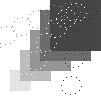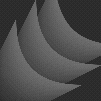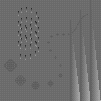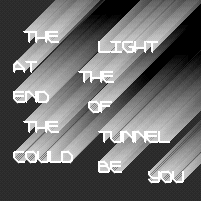
|
|
spring
Problem 2a:
Using the dot drawing technique described in Chapter 8 of the DBN book, manually position *exactly*
50 dots on your page that look as though they are randomly placed, but still form a cohesive
recognizable image that is non-typographic and non-symbolic.
|

|
|
coaster
Problem 2b:
In Primer of Visual Literacy (DD) read pp. 0-37. Using DBN, create a perceptual glitch, i.e. a visual
illusion. Your illusion should be constructed by reusing at least 1 similar part via use of the 'command'
command in Chapter 12 of the DBN book.
|

|
|
contact
Problem 2c:
In Passages in Modern Sculpture (RK) read pp. 0-67. Using DBN, create an image in the cubist spirit of
"The Guitar" (p. 51). You should use at least 5 'command' definitions.
|

|
|
iceberg at sunrise
Problem 3a:
Visualize a geometric progression (GP) of your choice in a concrete manner that emphasizes the wide
range of scales inherent to a GP. This is a simple exercise in Cartesian geometry that can look as
mathy as you like, or not.
|

|
|
winding road
Problem 3b:
Read DD pp. 38 to 66. Using the basic element of the Line and Dot, construct an image that is
evocative of the intent and spirit of a Line. Define this drawing as a single Command 'MyLine' that you
invoke just once.
|

|
|
eggshells
Problem 3c:
Read RK pp. 67 to 102. Evoke the image of an 'egg' shape: smooth, round, yet not entirely symmetrical,
using all the DBN knowledge you might have at your disposal. Think closely about how the surface of
the egg should be textured and decorated. Establish a clear underlying concept of computation, which
will be demonstrated by your cleanliness of code.
|

|
|
eraser
Problem 4a:
Read RK pp. 105 to 146. Reinterpret one of your previous pieces as a surrealist image. Include the
name of the previous assignment in your comments.
|

|
|
wizard of oz
Problem 4c:
Read RK pp. 147 to 200. Gather visual elements from at least three of your previous assignments, and
create a 'welded image'. Each of the visual elements should be in a separate Command (or multiple
Commands). Include comments to explain your choices and the resulting composition.
|

|
|
spinal
Problem 5a:
Using real sinusoidals, generate a shape with primarily convex properties.
|

|
|
amazing
Problem 9a:
Your display is now 200 by 200. Emphasize the difference between your early 100 by 100 display area
and the now larger 200 by 200 display area with a statically motivated graphic.
|









